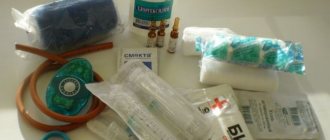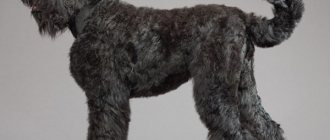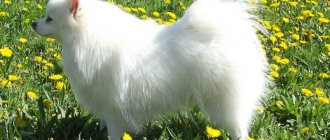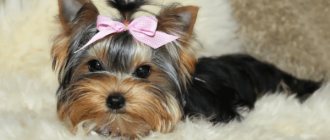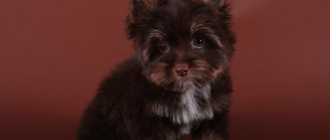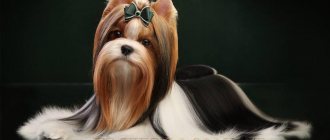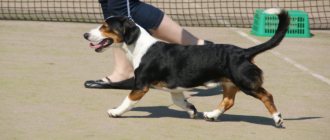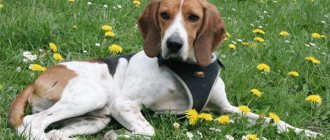The Mini Toy Terrier is a popular dog breed recently.
It attracts primarily due to its small size and easy care.
But in this breed, like no other, there are quite a few pitfalls.
Without familiarizing yourself with all the features of the character and build of this animal, you risk making a mistake in choosing a pet and getting a dog that is not the one you dreamed of.
To prevent this from happening, in our article we have made a comprehensive description of this breed, after reading which you can understand whether such a pet is suitable for you or not.
Origin story
Toy Terrier breed itself appeared in the 18th century in England. Initially, dogs were needed for small hunting and catching rats. Much later, high society became interested in this breed, and they became an adornment for noble ladies.
The last high popularity of these dogs occurred in the year 2000. After this, breeders began to notice that the demand for terriers had dropped sharply. This was due to the fact that many became interested in large fighting and guard dogs.
After this, many nursery owners and breeders decided to use a little trick. The smallest dogs began to be selected from the litter of toy terriers. The cultivation of this growth anomaly began. Thus, the resulting breed was even smaller than the Toy Terriers. They began to be called mini toy terriers, and their weight usually rarely exceeds 1 kilogram.
The very first representative appeared about 30 years ago. The appearance of these dogs on the market created a real explosion, after which interest in small breeds again increased significantly.
Nicknames for toy terriers
You can choose a real aristocratic name for your pet, and you will be absolutely right. The history of the breed lends itself to elegant nicknames: Felicia, Rose, Flozi, Holetta, Chatel, Sherry, Elton, Hildy, Jazzy, Leonora... You don’t have to use a “ready-made” name, you can get creative and come up with something of your own.
Owners often call their babies touchingly affectionate names: Sweetie, Cutie, Knopa, Rocky, Steve... They seem rustic for the character and origin of these dogs, but they reflect the love and tender attitude of the owners towards their pets.
Character traits
Many owners note the rather bad character of these small dogs. All their lives they are devoted to only one person, but even with him they often do not behave friendly. These dogs are real egoists, and it will be difficult for an unprepared person to get along with them.
They may treat other family members who may live with the dog throughout its life with disdain, sometimes aggressively. The breed does not get along well with children. Despite its small size, it can attack and bite.
You should show maximum attention to your pet when raising it, only in this case will it grow up calm and balanced. In any case, these terriers do not tolerate loneliness well. They yearn, whine and bark loudly. You should not get such an animal if you are rarely at home.
These are very emotional animals; excessive stress can lead to diseases of the nervous system. But they are very sensitive to all sounds and rustles, which is why they have a developed guard instinct. If loud and methodical barking bothers you, then you need to wean your dog gradually so as not to traumatize the psyche.
Girls are different in character from boys. They are more intelligent and sensitive to the mood of the owner. This feature persists throughout life. It is the females that are more amenable to training, education and generally the regime you need. Therefore, if you want a more flexible pet, you should get a girl.
Expert opinion
Kozhevin Semyon Kirillovich
Expert dog handler.
What can be said about mini toy terriers (both boys and girls) is that they are perhaps the “heaviest” decorative dogs of all. Their small size is simply a reason to let your guard down, because there can be even more problems than with the largest dog. If you do not find a common language with them, then it is better to immediately start looking for other owners, because this dog will not become either a faithful friend or a companion. Only if you correctly grasp the puppy’s temperament in childhood, will the adult toy terrier in the future respect and obey you, no matter how much she might want the opposite.
How long do they live?
Despite all its fragility, the Mini Toy is a very healthy breed that does not have many genetically predisposed diseases.
So, its representatives often live up to 15 years. However, due to their weak bones, they often suffer mechanical injuries from falls and small impacts on furniture.
To read: Cane Corso: breed standard and pet life expectancy
So don't let your pet jump off high chairs or sofas.
As for the most common diseases, these will be:
- hydrocephalus,
- aseptic necrosis of the femoral head,
- medial luxation of the kneecap,
- pancreatitis,
- cataract,
- hip dysplasia.
In order to avoid encountering these diseases, when choosing a puppy, you need to familiarize yourself with the medical records of its parents. If they were healthy, then their offspring most likely will not suffer from genetically transmitted diseases.
Advantages and disadvantages
Advantages:
- sweet and touching appearance that will touch anyone;
- it is possible to keep it in a small apartment or even a room;
- the dog eats less food than any decorative breed;
- it is easy to care for and carry;
- does not require long and regular walks;
- easy to train.
Flaws:
- excessively fragile complexion and brittle bones;
- you need to be very careful when choosing physical activities for your pet - almost anyone can injure him;
- You should pay great attention to the dog’s activities - he should not climb onto furniture or any heights, because any fall can be fatal for the dog;
- complex nature;
- in general, low immunity and susceptibility to disease;
- The dog is difficult to socialize and does not get along well with other pets.
Breed parameters
The height of an adult dog does not exceed 20 cm, and the weight should not exceed a maximum of 1.5 kg.
NOTE!
There is no official standard that would regulate all the characteristics of this breed. You can only be guided by the characteristics of a toy terrier and, by comparison, find out what a mini toy should be.
Key points in training
The mini terrier breed is able to recognize commands and learn quickly. Classes must begin from the moment the puppy appears in the house. Training miniature breeds is different from training large dogs and does not require teaching complex commands. The Mini Toy Terrier must understand the following rules:
- know your place in the house;
- do not ask for food from the owner's table;
- go to the toilet in the right place;
- do not bark without a reason;
- know your nickname;
- do not touch things or chew them.
Gradation by size
Below is a comparison of Toy Terriers depending on size:
- standard toy terrier and mini toy terrier . These dogs differ primarily in size. For an ordinary toy, the height is 25-30 cm and the weight is 3 kg. The performance of the mini toy differs almost significantly. We can say that the mini terrier is a smaller copy of an ordinary toy. But they differ, oddly enough, in character too. The standard terrier is more docile and friendly, unlike his brother, who has a rather bad temperament;
- dwarf toy terrier and mini toy terrier . Dwarfs are even smaller than mini-toys. Their weight almost never exceeds a kilogram, and their height is less than 20 cm. These are very timid and cute creatures that are almost entirely decorative. They are less mobile than mini terriers and require much more attention in maintenance and care. Such dogs are bred only for exhibitions, kept in special cages so that no one will injure them and so that they do not injure themselves;
- micro toy terrier and mini toy terrier . Micro toy (or as they are also called - super mini) is the smallest representative of the toy breed. Its weight barely exceeds 500 g, and its height at the withers is about 13-15 cm. A dog of this size is obtained only with an abnormality in height, because it is impossible to naturally breed dogs of such a small size.
Soft booth for toy
If you decide to make a soft booth for your little pet, then you need to cut out an oval from foam rubber, the size of which should be slightly larger than the size of the dog in a lying position. Then the walls, 25-30 centimeters high, and the ceiling are cut out of the same material. In one of the wall fragments of foam rubber, make a square hole with sides about 15 centimeters long. The ceiling can have any shape and with a creative approach you can make it removable by sewing on Velcro. A removable ceiling will give the dog additional space and more fresh, cool air during the hot season. Next, all the foam parts of the future booth need to be sheathed with dense, beautiful material, which will need about 2 meters.
Photos of colors
There are long-haired and short-haired mini toy terriers.
The Smooth-haired Toy Terrier is distinguished by a fur coat that lies close to the body. These dogs practically do not shed, and no lengthening of the coat is observed.
In dogs with long hair, on the contrary, feathering may form on the ears, paws and fur, while the hair on the entire body is elongated.
They are the same in color as standard dogs.
The main coat color is black and tan. It occurs in most dogs.
The next most common colors are black , chocolate and red. They occur in equal proportions in animals.
It is much less common to see a mini toy terrier of sable color and it is almost impossible to get a baby blue or lilac .
This result can be obtained by crossing two such dogs, which is almost impossible.
IMPORTANT!
Completely white color is a defect. Such animals are not allowed to participate in exhibitions.
Appearance
The dog's head is small, round in shape, with a well-defined transition to a pointed muzzle. The animal's thin lips fit tightly to small white teeth. The dog has a scissor bite. The nose is small, black or colored to match the coat. The terrier's small ears are set high.
The animal's eyes, large in relation to the head, look a little protruding. They are round in shape and set somewhat wide. Their color is defined by the standard as dark. The dog's close-fitting eyelids are colored to match the coat.
The head and body of the animal are connected by a long, slightly curved neck. The terrier's compact body is characterized by a straight back, rounded croup and short loin. The dog's tail points upward and is usually docked, leaving 2 or 3 vertebrae.
The terrier's oval chest is deep, but not wide, and his tummy is tucked. The front legs are set straight and parallel to each other. The rear ones are placed slightly wider than the front ones. The paws are small and oval.
Life expectancy and health
Due to their propensity for various diseases, as well as the risk of death if their owners are careless, such dogs, unfortunately, cannot please their owners for long. With the best outcome, their life expectancy is about 10 years.
Many cases where inexperienced owners start this breed end in failure. Dogs live even less in the family when they die due to an accident.
The most important risk factor for this breed, which also affects how long the pet will live, is overly brittle bones. This creates many problems during maintenance.
The breed is also susceptible to diseases :
- pathologies of the musculoskeletal system;
- diseases of the gastrointestinal tract (gastrointestinal tract);
- nervous system disease;
- eye damage;
- diseases of the oral cavity.
Mating, mating of dogs
Dogs must be brought together after puberty. The suitable age for males is 1.5 years, and for females - 2 years. By this moment, the animal has formed not only its body, but also its psychological state. Mating often takes place without any problems. However, the birth may require the assistance of a veterinarian. Due to the special structure of the body, pregnancy is more difficult, and childbirth may be accompanied by complications. Experts recommend having the dog examined at a clinic before mating to rule out further problems and contraindications.
Care and maintenance
The long-haired toy is more capricious in terms of grooming. It needs regular brushing, but a smooth-haired dog can be brushed only once a month.
Since these are miniature dogs, walking also has its own peculiarities. They will need special clothing during the cold season, and they may even have to purchase special shoes.
In addition, a regular collar will not suit them - they will need a special corset that will wrap around the animal’s body.
Your pet will need a tray in the apartment. The dog must be accustomed to it - this is part of the upbringing. Moreover, the tray will come in handy when the weather is unsuitable for walking such a fragile dog.
Your pet's place should be in a place where there is no overheating or drafts. It is best to keep him in a special enclosure, where he will be safe from all surrounding factors.
You need to clean your ears and trim your nails at least once every two weeks. You should also regularly inspect your dog's mouth for tartar.
Differences from the standard
The main difference is the size. Do not forget that a mini toy is just a smaller copy of a standard dog of the same breed.
They also differ in character. Regular Toys are friendlier than Mini Toys.
Their care also differs, but this is mainly due to their small size and fragile physique.
How to feed?
The diet should consist mainly of meat (lean chicken, beef and lamb) and offal. It would not be amiss to include sea fish, previously deboned, in your diet.
Dogs also need vegetables - carrots, bell peppers, zucchini, etc. They should make up one fifth of the pet’s entire bowl. One egg yolk once a week will also be beneficial for the animal.
An important component of the menu is porridge – rice or buckwheat.
Products must be combined in such a way that the dog receives the vitamins necessary for a harmonious existence in one meal.
If it is more convenient for you to feed your dog with dry food, then buy only premium or super-premium class. Keep in mind that it is better to pre-soak the granules in water. This way the animal’s delicate oral cavity will not be damaged.
NOTE!
Feeding this breed is one of the care features that is difficult to follow without consulting a specialist.
Factors influencing performance
Growth and development depend on proper nutrition. The diet should contain minerals and vitamins, especially calcium, and healthy fats.
Decide on the type of food - natural or food. Mixed nutrition is undesirable.
It is better to feed your puppy on a schedule:
- 1.5 – 3 months: 4 times a day;
- 2 – 4 months: 3 times a day;
- 4 – 6 months: 2 times a day.
Serving size for 3-4 meals a day is about 30 g. You cannot overfeed, otherwise excess weight will form.
Calcium and phosphorus are essential for strong bones and teeth . A calcium deficiency is indicated by the toy's ears. If they first rose and then hung, the puppy needs vitamins. Multivitamins should be introduced into the diet gradually, monitoring the pet’s health.
The puppy is taken for vaccination. The first vaccination is given at approximately 6 weeks .
This prepares the body for the next dose. The next vaccination is given at 2.5 months, it will protect the body from diseases - distemper, hepatitis, etc. If the puppy suffers some kind of disease, the consequences are irreversible.
For example, after the plague, chronic diseases of internal organs, blindness, and paralysis occur.
Every 3 months, puppies are given anthelmintic drugs for prevention . If the puppy is lethargic, eats poorly and does not grow, then this is a sign of helminth infection.
How to choose a puppy?
To choose a healthy and beautiful puppy , which will then turn into a wonderful dog, you need to follow some rules when choosing:
- Considering how difficult it will be to choose such a dog, be guided by weight. At two months the puppy should weigh about 700-800 g, and at four months it should reach its final weight of 1 kg;
- compare the puppy with the rest of the litter - he should look much smaller;
- In appearance, size should be the only distinguishing feature of a mini toy from a standard dog of this breed. The color, shape of the head, ears, body type should remain the same;
- The dog should not be cowardly or aggressive. Puppies, although mischievous from a young age, are quite curious and playful;
- evaluate the puppy’s exterior – the skin should be free of scratches, ringworm, as well as fleas and ticks;
- there should be no unpleasant odor or discharge from the mouth and ears;
- Despite its small size, the dog should not have any defects in appearance - it should not limp, its ears should not be broken, etc.
Selection rules
By purchasing an animal, a person takes on a friend for many years. Therefore, it is important to know what kind of toy terrier puppies should be. What you need to pay attention to:
- baby's behavior;
- parents;
- conditions of keeping the bitch and her litter;
- to the breeder.
A toy terrier puppy should give the impression of being a nimble animal and not differ from the rest of the litter. The coat is smooth, shiny, without defects, clean eyes and teeth.
It’s good if you have the opportunity to observe the parents of the toy terrier puppy. Most likely, he will turn out to be similar to them. If a dog's mother or father is aggressive, the offspring may become the same.
It is important to see in what conditions animals grow, mature, and their nutrition. You need to decide in advance who to choose, a girl or a boy. Determine the age of the toy terrier.
A good breeder will easily answer questions about the development of the puppy after birth, give advice, addresses of good veterinary clinics, and recommend food for the pet.
Expert opinion
Anna Abramenko
An avid dog lover. Experience in veterinary medicine since 2009.
Ask a Question
An animal is not a toy that can be changed. In order not to get confused and not be led by chance, it is better to create a table of signs that will help when buying a dog.
